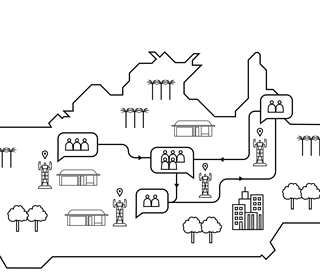Home relocation indicators describe the change in the home locations of subscribers between different areas.
This may be calculated in terms of the number of subscribers relocating out of an area (outflow), into an area (inflow) or the total change in the number of subscribers staying or residing in an area (net flow, the difference between the inflow and outflow). Usually, home relocations are expressed relative to the number of relocations during a baseline period, for example the median relocations per week for the three months prior.
How are home relocation indicators calculated?
We can calculate the inflow, outflow, and net flows of resident subscribers from an area using the pairwise origin-destination matrix for changes in home location for a given time period.
Find out more about how we calculate specific home relocation indicators here.
When interpreting relocation indicators, it is important to consider the types of relocations which may be less likely to be captured in CDR data.
If mobile device ownership and usage is affected by factors such as age, gender or socioeconomic status some journeys, relocations by some vulnerable individuals might be underrepresented. If they are less likely to be able to relocate than better represented individuals or relocate to different locations this could have important implications for decision making.
We also need to consider the methodology used to assign subscribers as residents to a given area.
There are a number of ways in which we could define subscribers’ home locations, such as the area in which subscribers were most often recorded, or were most often last recorded each day during a given time period. Each of these make assumptions about subscribers’ relationships with the area in which they are staying or residing.
The change in the number of people relocating between areas can have a range of implications.
For example, in the context of disaster and humanitarian crisis management, the change in number of relocations out of an area which has been forecast to be impacted by a disaster such as a cyclone or hurricane can provide useful insights into how people are responding to official warnings or evacuation orders. During and after a crisis, home relocation indicators can help determine the number of people who have been displaced and where they have been displaced to and from.
Discover our two main categories of flow indicators
Trips
TripsHome relocation
Home relocations

